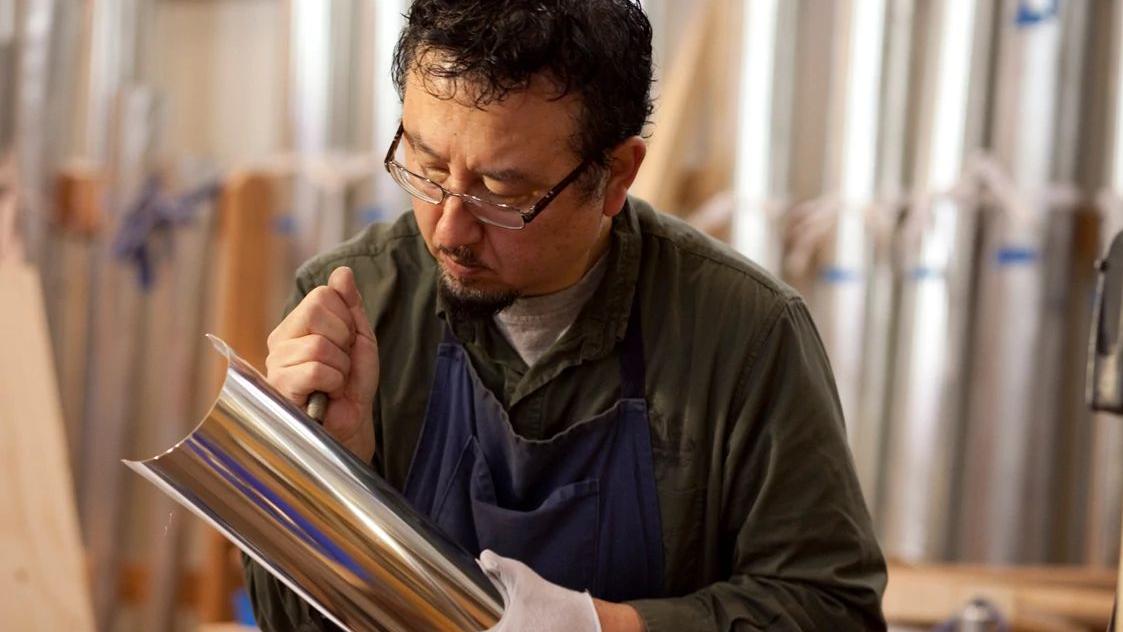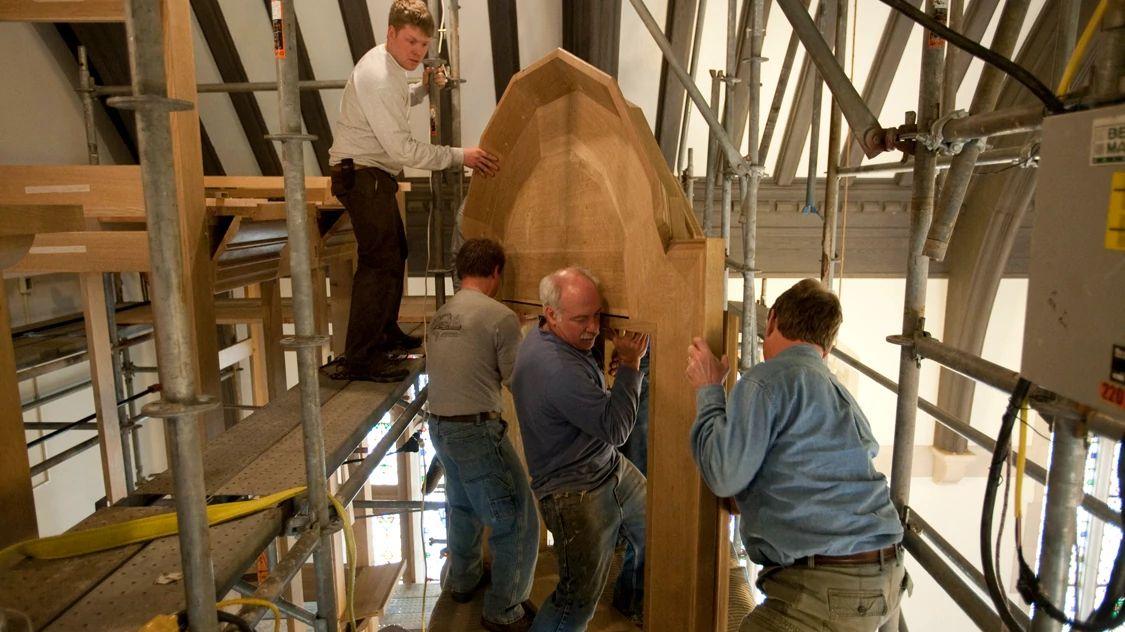An Old Model for a New Organ
Building Cornell's baroque organ has been a huge international project, made possible by email, scanners, cell phones and fax machines. Yet at the same time the project has followed a 17th-century organizational style. Organ building in Germany originated in the guild system, according to Anette Schwartz, chair of German Studies. Master builders such as Arp Schnitger, designer of the organs on which Cornell's was based, would travel to the construction site and supervise a large team of local carpenters and pipe makers. In just the same way has the Japanese Munetaka Yokota, designer of Cornell's organ, moved his entire family from Sweden to Ithaca for the year it is taking to assemble and voice the organ. Like a guild's master builder, Yokota supervised local craftsmen such as Christopher Lowe, builder of the case, and Parsons Pipe Organs, creators of the wind system and key action. "This is a brilliant coming together," says Schwartz.
Casting Pipes with lost techniques
"Munetaka Yokota is a meticulous craftsman and a brilliant organ builder who has done groundbreaking research on how old instruments were built," says Annette Richards, university organist and project manager. Yokota discovered a lost technique for pipe making that gives Cornell's baroque organ a unique character. The sheets of lead are cast on special fine sand before being rolled up to make the pipes. Because metal cools faster this way, the pipes have a different crystal structure and sound than those made with modern techniques. "The pipes are rather strictly built in the manner that organ builders in north Germany practiced in the late 17th and early 18th centuries," says Yokota, including how they cast the metal sheets and cut, rolled, and soldered them together. But one modification had to be made to how the pipes fit into the organ case. Oak releases gases that corrode pipes, which is why modern organ builders use plywood. In the 17th century, oak logs were transported by water, a process that leached out the corrosive gases. But no one handles logs this way any more, so Yokota instead sealed the gases by charring the places where wood and pipe metal meet.
Purer is not always better
In the 1970s, efforts were made to reproduce the baroque organ sound by making pipes that were pure lead, just the way it was done in the early baroque period - or so it was thought. Turns out 18th-century "pure" lead was a lot less pure than 1970 pure lead, so the modern pipes came out too soft. Cornell's metal pipes are a lead-tin alloy, just as late baroque pipes were. The ratio of lead to tin, as well as the addition of minute portions of impurities, were carefully crafted by designer Munetaka Yokota to reproduce the tonal quality of Arp Schnitger's Charlottenburg-Schlosskapelle organ, on which Cornell's was patterned. Yokota's casting method, and the entire pipe construction process, are based on his extensive research into baroque pipe-making techniques. The more tin content in the pipes, the shinier the final finish can be. But while the surface finishing for modern pipes is done by machine, Cornell's organ finish was done entirely with a hand scraper. "It's an extremely time consuming process that requires experienced hands," says Yokota. The end result, while impressively shiny, is not entirely even. "This is because the pipe wall thicknesses have been hand-adjusted in order to obtain the best physical and acoustical properties for each pipe," explains Yokota.
Voicing the Organ
Voicing the organ–giving each pipe the correct volume and timbre and ensuring that it responds correctly to the pressure and speed of the performer's touch–will take about half a year, says Munetaka Yokota, organ designer, builder, and pipe voicer. Although Yokota took into account the acoustics of Anabel Taylor Chapel when he designed the organ, it was impossible to predict exactly how the pipes would sound once the organ was assembled. It turns out that the acoustics in the chapel tend to accentuate very high pitches. Although every pipe produces overtones and some very high partials, Yokata discovered that in the chapel the pipes can produce a great deal of high frequency noise. "That kind of noise is too strong and destructive to our ear," he says. "But if the noise is reduced too much, the sound doesn't have a lively feeling." Yokota must make very fine adjustments to each pipe to in order to create the sound he wants, such as making the 8-foot flute sound less "shy," or giving a pipe an "extravagant character."
Building a Case
The organ case was created by local cabinet maker Christopher Lowe, who'd never before created anything of this magnitude. "It was a challenge just to get my mind around the scale of it at first," says Lowe. "But I realized there was nothing that I didn't know how to do, I just had to be ready to do a lot of it. The tolerances are really tight. We worked to about a thirty-second of an inch for all of our work, but that's on a scale of 25 feet." Challenges came from unexpected places, like the molding. "The points and polygons presented interesting geometric conundrums," says Lowe. "Not only the cutting of the joints, but the gluing up of those. One of the things people don't realize about putting furniture and cabinets together is that the clamping of the gluing joints is quite an art in itself. For some pieces there'd be just a forest of clamps trying to push these things into place and hold them." All the nails Lowe used were hand-forged in Sweden. He recalls that it "took us a little while to get used to the aesthetic. You're used to seeing the nail head holding something on, but in this case we would nail from the back and penetrate the surface, and then clench over the nail itself. It ends up looking like a staple but it's a rod iron nail."
Sustainable Wood
Most of the organ's wood is quarter-sawn domestic white oak, from the Ohio River Valley. But Chris Lowe, case builder, couldn't find quarter sawn white oak domestically that was long enough for the 18-foot long petal tower frames or for the main big timbers by the keyboard. He finally found the right oak from a forest in Germany that's been sustainably harvested for 300 years. The big timbers for the balcony frame and the bellows frame are recycled timbers from old mill buildings. Researchers looked around the globe for the perfect color to stain the organ's wooden surfaces and found it not ten mile away in Trumansburg, New York. Caput mortem, a red pigment in linseed oil, is an all-natural stain that matches precisely the color of the balcony wood. But after it was applied, Munetaka Yokata, organ designer, felt the wood of the case had become too dry. So Chris Lowe, builder of the case, put a layer of wax over the entire surface of the organ. By hand, of course.
The story behind the Colors of the Cornell Baroque Organ
Choosing paint colors for Cornell's baroque organ required detective work, a keen eye, and a willingness to experiment. Researchers knew from the documentation that the Charlottenburg organ had blue labels for all of the names of the stops, but they didn't know which blue, or why they were blue in the first place. It was an unusual choice. Only black and white photographs of the Charlottenburg organ survive. At a session during the March inauguration of Cornell's organ, Joel Speerstra, from the GOArt team in Sweden, explained how he reconstructed the labels. He was able to use the density of gray in the photographs to determine that the color of the stops wasn't cobalt, which washes out in black and white, but must have been Prussian blue newly discovered at the time of the Charlottenburg organ's creation.
The case of the Cornell organ is modeled after another Schnitger instrument in Clausthal-Zellerfeld. This case had nearly a hundred pieces of very elaborate and deep carvings that probably took a team of workers several years to complete; but Schnitger organs also sometimes had trompe l'oeil painting on flat pipe shades, although it is unusual to pair painted pipe shades with an unpainted organ, Speerstra noted. In order to ensure the shades would blend with the natural variations of yellow and red in the oak grain, Karen Speerstra, who has collaborated with Joel in painted pipeshade projects before, had the two main colors in the case wood digitally analyzed and copied and they used an undercoating of yellow with an overcoat of reddish brown, and combed the surface to look like wood grain while wet. This produced oak frames for the pipe shades, and then the two colors were also used as a basic pallette for the tromp l'oeil leaves and flowers, as well.
To create the models from which to cut out the pipe shades, Joel Speerstra projected images of the original pipe shades from Clausthal Zellerfeld onto the wall of a black box studio. "I put in lots of extra holes because I knew I wouldn't have to cut them out," said Speerstra, winking at Chris Lowe in the audience, the cabinetmaker who built the case for Cornell's organ--and who also built and painstakingly prepared all of the pipe shades for painting.
Sculptures? The Finishing Touch for Cornell's Baroque Organ
"One of the things that's always left out with new organs is the sculpture," says Todd McGrain, Cornell associate professor of art. But McGrain has been considering sculpture designs for Cornell's baroque organ since early in the project, with the encouragement of organ designer Munetaka Yokota. One of McGrain's ideas, to use cherubs as a unifying element, was presented at the 2006 Conference on the organ held at Cornell. Now that the organ is finished, McGrain says that "the somewhat understated, limited relief pipe shades has got me thinking that a more modern interpretation of sculptural elements for the organ might be more appropriate." McGrain envisions elements "that point toward the broad palette of both academic and artistic endeavors that are part of what make Cornell such a wonderful place." He cites the mosaic in Anabel Taylor Chapel as an excellent example of this type of synthesis. "That's what would drive my thoughts around the decoration for the organ," he explains. "Reflecting on Cornell as a place with such a beautiful breadth of expertise and interest, and asking what sculpture is appropriate for an institution that's about nurturing the questioning mind." Declining to go into specific designs for sculptures, McGrain says "we live in a world where people like to know where they're going and set a plan and then they judge the success or failure by whether or not they got what they wanted. But the job of a sculptor is to be inspired by an initiative, start down the road of development, stay sensitive and inquisitive, and answer the questions through the process of creation so that the thing that's made is a result of a truly evolutionary development and transformation of materials suitable for the site." As to what material would be suitable for Cornell's organ sculptures, McGrain says that northern Europeans were masters of direct plaster over wooden armatures. It's a traditional technique that McGrain uses extensively in his own art, although his current work, "The Lost Bird Project," is made of bronze, and he also works with carved wood and cast plaster, techniques also employed by baroque sculptors. Any work on the sculptures for Cornell's baroque organ, however, will have to wait for funding to be found.
Reflections on a completed Project
Cornell Professor of Music, David Yearsley, wrote two connecting pieces reflecting on the work of Munetaka Yokota, and the rebirth of the Charlottenburg organ at Cornell. Find these short reflections here and here.



